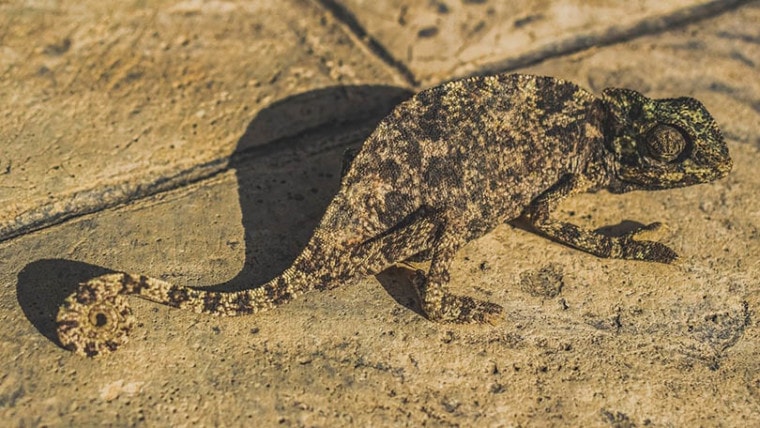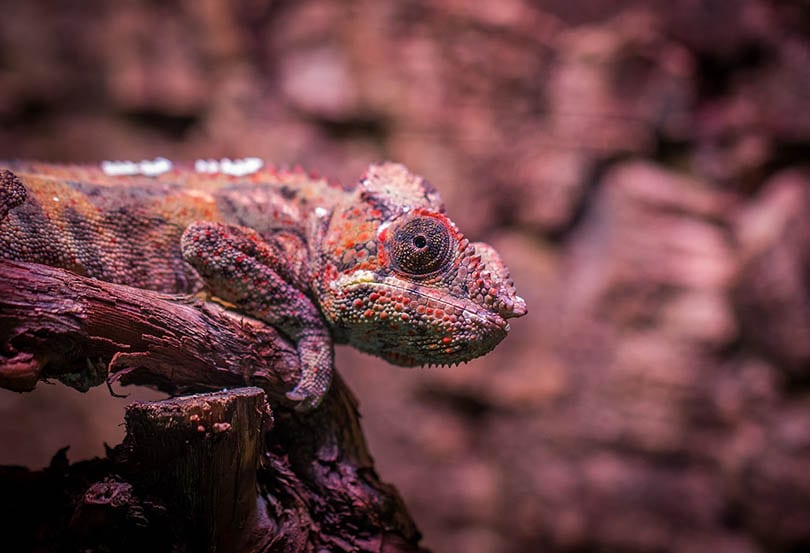
If you own a pet chameleon, one of your reasons for doing so is probably because of their awesome color-changing abilities. But did you know that they do this as a result of specialized cells in their body and have a range of colors greater than most?
As you likely know already, the reason your chameleon changes color is to blend into his surroundings—at least that’s what we always assumed. But, a lot of your preconceived notions about why chameleons change colors might actually be somewhat wrong.
As it turns out, not every color a chameleon changes to is a form of camouflage. So, why do they carry out this entertaining act? And how do their specialized cells actually work? These are things that have always puzzled us and now we want answers. Let’s get you those answers in this article.
How Do Chameleons Change Color?
Most animals have pigmented cells that reflect light in order to express a certain coloring. But the difference between chameleons and other reptiles is that their reptile friends have cells that are only capable of absorbing and reflecting certain colors.
With chameleons, their pigment cells, called iridophores, essentially act like mirrors and are capable of reflecting a much wider range of colors. Pigments are held in tiny sacs inside the chameleon’s body. But when a chameleon responds to an external stimulus, the iridophores move either closer together or farther apart, giving them the ability to reflect different colors of light.
When the cells move closer together, they can express darker colors that have shorter wavelengths, such as blue or purple. When they move farther apart, they express colors with longer wavelengths, such as red or orange.
How can we see the color changes if the cells are inside a chameleon’s body? It’s because the top layer of a chameleon’s skin is actually transparent, allowing us to see the different colors underneath. Keep reading to learn what can affect a chameleon’s color.

The 2 Reasons Chameleons Change Color
You’ve seen cartoons and videos in which a chameleon can change to match the color of any background for the purpose of blending into his surroundings. Of course, you didn’t actually expect your pet chameleon to be able to perfectly match a floral background in order to avoid being seen.
No, chameleons can’t transform themselves into crazy patterns like they do in cartoons. But what they can do is express certain colors as a form of camouflage. However, those colors won’t be bright blue, red, or purple, for example.
When chameleons are using their color as a form of camouflage, they are usually green or brown to blend in with whatever tree limb they happen to be sitting on. This is purely a defense mechanism to avoid being seen by predators since they have pretty much no other way to defend themselves.
However, when they do this, they technically aren’t changing their color at all as green or brown with a specific, stick or leaf-like pattern on their skin are the natural colors of a chameleon, depending on the exact species.
In this natural state, the chameleon’s cells are the normal distance apart from each other.
Even though it’s partially true that chameleons use their color for camouflage, this is not the reason that they change to other colors besides green. So, why do they change color then? Here are the two main reasons.

1. To Express Their Mood
One of the main reasons that chameleons change color is to express their mood. For example, chameleons that are their natural color of green or brown tend to be in a relaxed state, hence the need for them to blend into their surroundings.
If they aren’t feeling particularly aggressive, they are simply trying to relax and want to avoid being seen as a result. This is much the same way that humans may go into their bedroom and close the door if they want some peace and quiet.
If your chameleon very quickly changes from its natural color to a brighter color such as blue, red, yellow, or even a much more vivid green, it is likely a sign that he is feeling aggressive. These quick color changes happen most often with male chameleons as a result of trying to defend their territory from another male or something else that they perceive as a threat.
In the wild, if a chameleon dims his bright colors in the presence of another male, it usually means that he is weaker and is either showing defeat or expressing that he doesn’t want to fight.
A chameleon may also turn bright red if he is excited or angry. Dark colors that can appear almost black may be an indication that your chameleon is sick or stressed. Brown colors (if your chameleon is normally green) might indicate that your chameleon is feeling a little sad.
In wild chameleons, brown could also be a sign of brumation, which is essentially hibernation for cold-blooded animals such as lizards. However, pet chameleons usually don’t undergo brumation because they are kept in a regulated environment.
As the owner of a chameleon, you can actually learn to read his mood based on what color he changes. In most cases, a chameleon should return to its normal color after he feels that whatever has threatened or excited him has passed. If your chameleon stays one color that is different from his usual color for longer than what you feel is normal, particularly a darker color, it could be a sign that something is wrong.

2. As A Mating Ritual
Sometimes chameleons change to brighter colors to indicate that they want to mate. The exact color that they turn can depend on the species, but usually, the color will be red, blue, or yellow, especially in specific areas of their body, as an attempt to stand out to females.
Female chameleons may also change color if they are not interested in mating or have already mated. They may develop a dark stripe across their body as a warning sign to any males that try to mate with them.
Other Theories
There is another scientific theory that has recently come about that says that chameleons may also change color as a way to regulate their body temperature. Although this is the purpose of having a heat lamp for your pet chameleon, the theory is that a chameleon may change to a darker color if he is cold in an effort to absorb more heat and change back to a lighter color when he warms up. But there is still very little research to actually confirm this theory.

Do All Chameleons Change Color?
All species of chameleon are capable of changing colors. However, the differences between the species are what color they are in their natural state and how quickly they can change into different colors.
Not all species of chameleon are kept as pets. The most common one that is kept as a pet is the veiled chameleon, which is a light green when expressing his natural color. They actually won’t even start to show different colors until they reach a certain age. When they do start to change colors, they can do so in 20 seconds or less.
Yellow stripes are a common pattern for veiled chameleons. It happens especially when they are feeling particularly aggressive and don’t want to be handled or see their reflection and think it is another male chameleon trying to come into their territory. It’s also not uncommon for a veiled chameleon to turn brown, but he should return to his original green. If he doesn’t, it could be a sign that he is sick.
Other species of chameleons that aren’t usually kept as pets can exhibit different natural colors depending on the region where they live. For example, the panther chameleon is one of the most colorful species. He lives primarily in Madagascar and can be green, teal, red, or even a combination of colors in his natural state just depending on where in Madagascar he actually lives. And just like the veiled chameleon, he can change colors in as little as 20 seconds or less.
Conclusion
Chameleons are like the mood rings of the animal kingdom. Only their natural color is used as a form of camouflage. Other colors are a reflection of their mood. By paying attention to the colors that your pet chameleon changes and his behaviors when he changes different colors, you can learn a lot about your scaly friend.
Next on your reading list:
Featured Image Credit: dimitrisvetsikas1969, Pixabay









